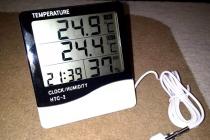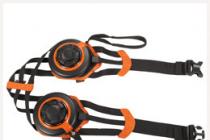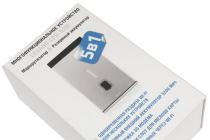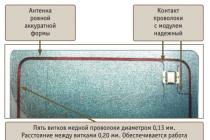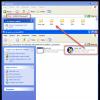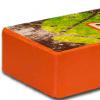Even if a person is not an audiophile, he still loves convenience and comfort. And it's hard not to agree that it's inconvenient and uncomfortable when you, trying to drown out the noise of the subway, want to listen to music, only to find that the cable of your headphones is tangled. Also, hardly anyone likes it when the sound is muffled by the vibration of the wire rubbing against the clothes. Naturally, it is much more convenient not to have these wires at all. If you're also a fan of convenience, then you should definitely check out some wireless Bluetooth headphones.
Wire problems
Many people spend a lot of time looking at the screen of their smartphone while listening to music, most often on public transport. You can also walk down the street while listening to an audiobook or your favorite podcast. In doing so, you naturally periodically check your phone by taking it out of your pocket and then sending it back. Headphones at the same time complicate the process just because of the wires. What do you do with excess wire? After all, most headphones have a longer wire than you need. Naturally, you put it in your pocket along with your phone so that it does not hang out and get in the way. Wire length control is a bit of an annoyance, but it has to be dealt with every time you take your phone out of your pocket and put it back in. Another annoyance is the organization of the wire under your jacket or under the strap of your bag.
Advantages of wireless headphones

What about wireless headphones? With wireless headphones, you can safely take your phone out of your pocket and put it back in, no problem. In addition, the absence of wires opens up new pocket possibilities that would be difficult to implement with wires: back pocket, inside jacket pocket. A whole new world opens up - the world of pockets. If you do not need large headphones, then you can consider purchasing fairly inexpensive models that will still be of sufficient quality. And prices may gradually come down as the wireless headphone market gradually grows and matures, as the demand for such headphones is constantly increasing. Many of these devices are described as fitness devices, and indeed, the absence of wires is even more attractive if you run or do any other type of physical activity, and the wire dangling in all directions constantly interferes with you.
One of the best models

You can pay special attention to the model, which today has almost the best value for money. We are talking about Ankers headphones. Will you get the highest sound quality for $37? Of course not, the sound quality will be good, but not excellent, and even more so not the highest, but at the same time the price will be much lower than that of higher-quality competitors. This model sounds good. And she has a very interesting magnetic mechanism that automatically turns the headphones on and off. But for less than forty dollars, it's a great choice that gives you all the features you need and good sound quality. However, this article is not about a specific model. This article is meant to set you free. Free from wires.
Music without borders
Many people are reluctant to let this new technology into their lives. Many claim that it brings more problems to life than it solves. Yes, you will need to charge your headphones every few days. Yes, the sound sometimes disappears due to some invisible and incomprehensible barrier. But at the same time, you can enjoy the fact that you are no longer tied by a wire. You can enjoy the fact that you no longer have to fiddle with wires under your jacket every time you want to look at your phone screen. And you will never again have to experience the effect of a stethoscope every time something rubs against the wires of your headphones. It is very nice. And there is nothing pleasant in the fact that you are tied to your device. You can choose whether you want to be free.
Hello fellow friends!
Uncle doctor - it'll be me!
My robe is in my suitcase
Stethoscope always in your pocket
Let's take the head if necessary.
It is difficult to imagine a modern doctor without a listening instrument hanging around his neck, called either "ears", or "tube", or something else. In my nickname-forming student song (see epigraph), this instrument is called a stethoscope. Let's try to figure out what it is and why it is needed.
Doctors - such, infections, meticulous. They need to know everything about the patient. It is not enough for them to take his soul out of him, to ask about all the little things in the life of himself and his relatives up to the ninth generation. They want objective reality, which is given to us in sensations. For example, to feel the patient, especially if it is a young sympathetic patient, blushing from the touch of the doctor's cold shaking hands. Or knock on it. No, not with a hammer, although this is also interesting - the legs are twitching so cool, but with the fingers. Or listen to what kind of sounds are heard in the patient's inner world. The first method of examination is called "palpation", the second - "percussion", the third - "auscultation".
We'll talk about auscultation today. Her possibilities are very wide. You can, for example, hear the onset of pneumonia and accurately establish its localization. Or determine the caliber of the bronchi affected by bronchitis. Or hear the noise in the heart, characteristic of a particular defect. Or detect - "is" the intestine after abdominal surgery or has already "started". Opportunities - weight.
knock speed
However, it is impossible to completely do without a story about percussion. At least in order to maintain continuity. And remember one doctor, whose name was somehow lost in the wilds of history. Undeservedly. We are talking about the Viennese doctor Leopold Auenbrugger (1722-1809), the author of the percussion method.
As the son of an innkeeper, Leopold often watched his father determine the amount of wine in barrels by tapping their walls. It is possible that it was these observations that led him to the idea of using percussion to determine the presence of fluid in the chest cavity.
For 7 years, Auenbrugger studied the sounds made by tapping the chest in healthy and sick people. He systematically correlated his clinical observations with autopsy data. So in 1761 a 95-page work appeared. "A new discovery that allows, based on the data of percussion of the human chest as a sign, to detect chest diseases hidden in the depths" (Inventum novum ex percussionae thoracis humani ut signo abstrusos interni pectoris morbos detegendi).
It is today that we know that tapping is cool and informative, but then percussion was met at best with derision, at worst - openly hostile. The Viennese doctors and their patients, who only felt their pulse, condemned the "long and painful procedure." But for its implementation it was also necessary to undress the patients. And the patients too. Moreover, the method was not recognized by Auenbrugger's teacher, rector of the University of Vienna, founder of the Viennese clinical school Gerard van Swieten (1700-1772). Leopold had to leave the university and leave the practice in the Spanish hospital in Vienna. The great doctor ended his years in a madhouse, where he died in 1809.
Nevertheless, the falling banner of the new method was picked up in France, and not just by anyone, but by the founder of the national clinical medicine, the physician of Napoleon I, Jean Nicolas Corvisart de Mare (1755-1821). Corvisart learned about percussion by accident, from a small work by the Viennese physician Maximilian Stoll (1742-1787), who used this method in a small hospital for the poor on the outskirts of Vienna. "I do not remember even once, during the whole time when I studied medicine, that the name of Auenbrugger was mentioned. I did not know percussion when I started teaching clinical medicine," Corvisart wrote.
He developed and improved the Auenbrugger method, translated into French and thoroughly supplemented "Inventum novum", publishing a 400-page work.
Listen to me, banderlogs!
Not to say that the idea of tapping or listening to a patient is super revolutionary. It is believed that they were known back in the time of Hippocrates, only they were used quite limitedly, for example, they tapped out only liquid in the stomach (ascites). And the listening method had one, but a serious technological flaw - the doctor had to put his ear to the patient's chest. And in this form, the method of auscultation, more precisely, direct auscultation, was taught to many generations of doctors. He was also taught by Jean Corvisart, who lectured in the amphitheater of the Charité hospital. The young René Theophile Hyacinthe Laennec (1782-1826), who was to make such a small revolution in medicine, also listened to these lectures.
By the way, all the prerequisites for this were. Rene was brought up in the family of his uncle, a famous doctor during the French Revolution. Studying Greek and Latin, Laennec already in his youth read the works of ancient Greek and ancient Roman authors in the original. In his student years, Jean Corvisart had a great influence on him.
While still a student at the University of Paris, Laennec became interested in consumption (tuberculosis), which at that time mowed down the population no worse than the plague. Rene tried to find a method of early diagnosis, because when the patient began to cough up blood, nothing could be done. There was still a lot of time before Roentgen discovered the name of himself (1895), direct auscultation did not give any tangible results, and it was problematic to put your ear to each patient. Sometimes banal lice interfered, sometimes - young age and belonging to the female sex (especially in combination with a noble origin), sometimes - an excessive layer of subcutaneous fat.
An apple fell on Newton, Mendeleev dreamed of the table, and Laennec was helped by children. Returning from the clinic through the Louvre park, he drew on a gang of children frolicking around the logs of the scaffolding. Some children put their ear to one end of the log, while others enthusiastically beat the other end with a stick. The sound, passing through the tree, intensified.
The opportunity to test my guess in practice also turned up quickly. He was called to a 19-year-old chubby lady who needed to listen to her heart. How to do it? The deushka is full, the heart is audible bad - after all, with direct auscultation, the heartbeat was heard mainly from the back, not to climb between the breasts;) Then Laennec asked for several sheets of paper, rolled them into a tight tube, put one end of the tube to the girl’s chest, and the second - to his ear.
“I was equally surprised and satisfied when I heard heartbeats so clear and distinct as I had never heard them even with direct application of the ear to the region of the heart,” Laennec later admitted. This is how the method of mediocre (or indirect) auscultation was born, which revolutionized diagnostics.
The evolution of the stethoscope
Invented device Laennec called "stethoscope" (stethos - chest, skopeo - look, explore, Greek.). At first he glued them from thick paper, then he began to experiment with different types of wood. His own stethoscope was very different from what we are used to seeing today. It consisted of two wooden parts that could be connected together or used separately, depending on specific purposes.
With the help of a stethoscope, Laennec was able to carry out his research on pathology, clinic and diagnosis of lung diseases with maximum efficiency, which, in fact, is his main contribution to medicine. In addition, he described auscultatory signs of heart defects, studied the clinic and pathomorphology of portal cirrhosis of the liver, which is still called Laennec's cirrhosis to this day, established the specificity of the tuberculous process, described the formation of "tuberculosis", by which he gave a new name to consumption. Long before the work of Robert Koch, Laennec considered tuberculosis to be a contagious disease, and as a treatment in the early stages he offered increased nutrition, rest and sea air.
Laennec's most famous work was published in 1819. It was called traditionally long and ornate: "On mediocre auscultation or recognition of diseases of the lungs and heart, based mainly on this new method of research". Seven years later, René Laennec died of tuberculosis. He was overtaken by a disease, for the study of which he, perhaps, did more than anyone else.
Not to say that a cloudless future awaited the stethoscope. Many doctors did not accept it, for example, in the USA. The founder of the American Heart Association, Professor Connor, until the end of the 19th century, preferred to press his ear against a silk scarf draped over the patient's chest.
However, the method and tool began to gain popularity. They began to develop and improve. This is how the familiar wooden stethoscopes with bells appeared, which increased the area of contact with the patient's skin and the doctor's ear.
Later, tubes were attached to the wooden (or ebonite) parts, which were inserted into the doctor's ears:
The tubes were not only metal, but also rubber:
The pursuit of the "right" sound sometimes led to very unusual results. Such, for example, as Alison's "differential stethoscope". It was believed that two separate heads should create a stereo effect. In fact, such a tool turned out to be very difficult to use:
In 1894, the first phonendoscope appeared. It differed from a stethoscope by a membrane that covered the entire working surface. It improved the conduction of sound, it became possible to hear more nuances:
Later, "ears" began to be made with two heads, one of which was a flat and closed membrane, and the second was made in the form of an open cone. However, there were "budget" options with one head and a removable membrane. The two-in-one combination is officially called a stethophonendoscope, but in the medical environment I have never heard this term;)
The stethoscope in the Rappaport-Sprague modification acquired a completely familiar look in the 40s of the XX century. The classic rappaport performed, by the way, by Hewlett-Packard, looks like this:
In the 60s, a modification of Harvard University professor David Litman appeared, lighter and more compact than bulky rappaports:
By the way, classic wooden stethoscopes are still used in some places. They are especially loved by old-school obstetrician-gynecologists for listening to the fetal heartbeat.
Now it has come to computer systems called stethophones - up to the analysis of sound and the issuance of a preliminary diagnosis, it comes down to it. However, nothing can replace the ears of an experienced doctor.
My first "pipe" was a classic Polish-made Litman, inherited from my father. And the "workhorse" is still the Japanese rappaport with a bunch of attachments.
One of the most important aspects of the development of cardiology and the diagnosis of cardiovascular diseases was the creation of a stethoscope. This invention made it possible to obtain a reliable and high-quality tool for determining the state of various internal organs, and promptly making a diagnosis without interfering with the work of the body. Its creator laid the foundation for a unique diagnostic technique of auscultation, which has many advantages, as a result of which it is actively and effectively used today.
History of the inventor
The inventor of the stethoscope was Rene Laennec, a hereditary French doctor and researcher who was actively involved in diagnostics and studying the features of the work of internal organs. He was born in 1781 and brought up by his relative, a well-known doctor, who from childhood instilled in him a love of science and taught him many wisdoms of the profession. Even in his youth during his studies, Laennec showed very good results, and despite his very peculiar character, he easily gained respect among eminent teachers.
After studying and starting practice, he entered the service as a surgeon, where he was able to demonstrate and hone his skills. In this regard, after the service, he was invited to work in one of the leading Parisian clinics, in which he worked under the supervision of Napoleon's personal doctor, Corvisart. There he actively took up scientific activity, published several interesting articles and began to specialize in studying the work of the heart muscle, starting with the works of Hippocrates, who first described the structure and features of this organ, and ending with the knowledge of his contemporaries, as well as diagnostic technologies, such as applying the palm of your hand and percussion . In France at that time, using these methods, doctors determined the features of the heart and could quickly make a diagnosis.
Brilliant idea
Once in his practice, an interesting incident occurred, which served as the reason for the creation of a unique device, and subsequently a fundamentally new diagnostic method. Laennec was invited to see a well-known lady with pain in the chest area, but when he arrived, he found that due to her overweight and large body fat, standard methods simply did not work for her.
After some thought, he remembered an interesting fun that he had learned as a child - if you put your ear against one side of a large log, and lightly tap it with a needle from the other end, the sound will be heard very clearly. Then the doctor rolled up the magazine, leaned one end against his chest, and put his ear to the other. Thus, he was able to hear all the features of the heartbeat very clearly, and the quality of the sound led him to the idea that this method could also be applied to the study of other organs.
After this incident, he independently began to create a prototype, tried many different options, and in the end chose a walnut tree, from which he carved a hollow cylinder. That's how "Le Cylindre" he called his own invention, which immediately showed amazing results. Using his device, he was able to fully describe the clinical picture, and suggested the most effective treatment.
Invention Development
It took him about a year to conduct the necessary research on various patients. Then, in 1818, he presented his discovery to the French medical community, and gave a paper on a new method of indirect auxulation. At the same time, he spoke in more detail about heart diseases that he managed to identify using a stethoscope, the name of which he had already changed by that time. Another of his outstanding achievements, which he presented to his colleagues, is a description of the features of pulmonary tuberculosis. He paid a lot of attention to this disease, and provided effective methods for the treatment of this disease.
Laenek's further career was strongly associated with the use of a stethoscope to determine the characteristics of a particular disease. In his scientific research, he published a lot of interesting information about the features of a whole list of diseases of the lungs, heart and other internal organs. However, other doctors began to use the stethoscope with great interest, thanks to which this invention, and with it the whole new diagnostic technology, became really popular and effective in just a couple of decades.
Over time, after the death of the author, who died of tuberculosis, some changes were made to the design of the device, and it was modified to a device called a phonendoscope, which has a specialized membrane that makes it even easier to hear the features of the work of various internal organs and even measure blood pressure.
The phonendoscope has now become one of the most important and indispensable tools in the work of almost every doctor, and most of the necessary important information about the patient is learned by specialists using it. The discovery of the stethoscope opened a whole new chapter in the field of diagnostics, and allowed medicine to take a huge leap.
A stethoscope is a medical device with which it becomes possible to conduct auscultation, that is, to listen to the sounds that are present in the heart, blood vessels, lungs, intestines, bronchi and other internal organs of a person. The most well-known areas of application of this device are listening to Korotkoff sounds in the process of measuring blood pressure, as well as determining the location of the probe inside the stomach during gastric lavage or enteral nutrition.
The head, which must be applied to the surface of the human body in the place necessary for listening and which has the ability to capture various sounds in the organs, serves as the working part of the stethoscope. Other parts of the device are flexible sound-conducting tubes, through which sound enters the specialist's auditory canals for analysis.
There are also non-medical models of stethoscopes, the purpose of which lies in the technical diagnostics of the functioning of various mechanisms - the crank mechanism, bushings, assemblies and parts. In a technical stethoscope, the sensitivity of the device is given by a thin metal rod, which is leaned against the place of study.
History of occurrence
Back in 1816, the French physician Rene Laennec, who is the progenitor of the diagnostic auscultation technique and the entire scientific method of diagnosis, invented the first stethoscope. In those days, to listen to the internal organs of patients, it was customary to put the ear to their body, which the innovator categorically did not want to do, therefore he used folded paper for this purpose, which perfectly conducted the sound, making it even clearer than with direct listening using ear attachment. Since that time, the stethoscope has been modified and improved, but the principle of its operation and physical characteristics have remained the same.
In 1894, an improved stethoscope was proposed to be called a phonendoscope by professors of physics and preparatory clinical medicine A. Bianshi and G. Bazzi. The stethoscope acquired its modern look in the 1940s, when Sprague and Rappaport improved it, creating a new example of a standard for this device. Today it is called so in the scientific community - the Sprague-Rappaport stethoscope.
A modern device called a stethophonendoscope helped to combine a stethoscope funnel and a phonendoscope membrane in the design of a two-sided head. The term "stethoscope" today refers to both a phonendoscope and a stethophonendoscope.
The design of stethoscopes
 The design of a modern stethoscope necessarily contains:
The design of a modern stethoscope necessarily contains:
- head;
- membrane and funnel;
- sound pipeline;
- temples;
- olives.
The head of the stethoscope is the part that must be applied directly to the patient's body in order to capture and amplify auscultatory sounds inside the organ being examined. The heads are double or single sided. On one-sided heads, either funnels or membranes are located (in most cases). On bilateral, on both sides of the head, there is both, or on both sides of the head there are membranes of different diameters. With double-sided heads, to switch them, it is enough to turn the fitting 180 degrees, which is structurally connected to the sound duct.
To capture high-frequency auscultatory sounds, it is more rational to use a membrane, which is more sensitive in this case, and a funnel is better suited for low-frequency sounds. The membrane is understood as a flat or slightly convex outward, by analogy with the glass of a wristwatch, a plate mounted on the head of a stethoscope. It can usually be changed over time or easily changed if necessary. Epoxy membranes reinforced with glass fiber material are supersensitive, while polyvinyl chloride membranes are less sensitive.
The sound duct is a flexible elastic hose with which sound is conducted from the head of the device to the hearing aid (in other words, ears) of a specialist. Sometimes the head is connected to one, and sometimes to two sound ducts. But even in the case of a single sound duct in front of the arms, it is necessarily divided into 2 parts.
The arms of a stethoscope are a pair of metal tubes that are connected to a sound duct. The springs of the temples provide a tight fit of the olives to the auricles. The tips of the temples can be positioned forward so that the olives can be inserted into the ears at an angle to the ear canals.
Finally, olives refer to two rounded tips with hard or soft texture temples that provide a comfortable fit of the stethoscope in the external auditory canal of the examiner using the device. Olives differ in size, they must be individually selected in accordance with the size of their own auditory canals. Olives, as well as membranes, can be easily replaced in the structure of this device with new or more comfortable ones. Ideally, the olives fit comfortably around the examiner's ears, neither pressing too hard nor falling out of them. Thus, the closedness of the sound duct system is ensured, which avoids the appearance of an empty space between the olive and the ear and ensures a high quality of auscultation.
Varieties of the device
The stethoscope can be subdivided in medical practice according to the categories of patients for which it is used in the practice of physicians. Thus, a therapeutic stethoscope is designed to listen to adult patients, a neonatal stethoscope - newborn babies under the age of 28 days, and a pediatric stethoscope is used to auscultate pediatric patients. The last 2 types of the device differ from the therapeutic one in the smaller size of the listening head.
In the practice of doctors, the Rappaport stethoscope is widely used, which is distinguished by its versatility with respect to patients of any age. Its distinguishing feature is a massive double-sided head, on which it is possible to install different nozzles - 3 types of funnels and 2 types of membranes, as well as equipment with two independent sound ducts to ensure sound transmission quality. The only disadvantage of this device is its large weight.
Also, stethoscopes are divided into types, depending on the specifics of the work of a specialist. Cardiac stethoscopes are distinguished by increased acoustic characteristics, which provides a much larger sound spectrum when listening to heart sounds. A fetoscope or Pinard stethoscope is used in gynecology to listen to the heart sounds of the fetus during pregnancy. It is most similar in design to the first devices that were invented 2 centuries ago. This is a stethoscope in the form of a rigid tube with a two-ended bell. When measuring blood pressure in patients, a simple device is used, equipped with a single head with a membrane.
In modern medical practice, an electronic stethoscope is also widely used today, containing a microphone in its head, which is capable of converting sounds perceived by the device into an electronic signal to be processed and output to speakers that are built into the olives of the device. It can be used to perform auscultation with double conversion of the received sound in the adult category of patients.
Scientists from Ben Gurion University located in Israel YouTube videos, the headphones can be easily modified and function as recording microphones. The secret of such a transformation lies in the usual physics, which are held in high school. So the speakers in the headphones convert electromagnetic signals into sound waves by vibrating a special sensitive membrane. But these membranes can also work in the opposite direction, that is, they can receive sound vibrations and convert them into electromagnetic signals.
In one of the videos posted on the Vice News portal, Snowden demonstrated how you can protect yourself from wiretapping by removing the internal microphone from a regular smartphone. In addition, the iFixit website also demonstrated in their video how to turn off the microphone on MacBook Pro laptops.
JavaScript is disabled in your browser
As Mordechai Guri noted, this problem is very serious, because even after removing the microphone from the computer, the user's conversations can still be recorded through the headphones. At the moment, the vulnerability affects Realtek chips, which means it cannot be fixed with a software patch. The only way to avoid attacks is to upgrade your hardware or stop using your headphones.
In fact, everything described above is a long-known common truth, since the process of wiretapping has long been studied and called " microphone effect ".
As the encyclopedia describes, " microphone effect" - this is an undesirable phenomenon in which some part of the electrical circuit perceives sound vibrations and vibrations like a microphone. It most often occurs when capacitance changes, especially in high-frequency circuits, where even slight fluctuations in poorly fixed parts can significantly affect the parameters of the main signal.
Anatoly Torokin in his book Engineering Information Security, describes the physics of the process: " Acoustoelectric transducers include physical devices, elements, parts and materials capable of creating equivalent electrical signals under the action of variable pressure of an acoustic wave. The properties of acoustoelectric transducers are used according to their functional purpose to create microphones of various types. But there are a variety of radio-electronic and electrical elements and devices that have the so-called "microphone effect", that is, capable of converting acoustic signals into electrical ones. This leads to the appearance of dangerous signals in these radio and electrical devices, which create the prerequisites for information leakage."

